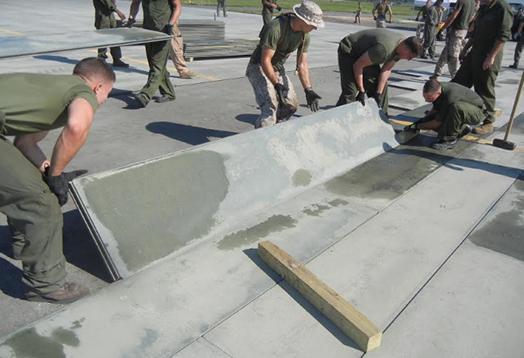
Credit: Pablo Zavattieri/Purdue University
WEST LAFAYETTE, Ind. – A $1 million SBIR Phase II grant from the U.S. Air Force will help fast-track the development of a new innovative runway mat.
Pablo Zavattieri, the Jerry M. and Lynda T. Engelhardt Professor in civil engineering at Purdue University, is working with Indiana Technology and Manufacturing Companies (ITAMCO) to develop the new runway mat. The team uses metal 3D printing methods for its technology.
“The objective of the research is to develop a robust sheet or roll technology that serves as an alternative to the AM-2 mat for temporary or expeditionary flight operations,” Zavattieri said. “AM-2 matting has served the U.S. military well since the Vietnam War, but the materials and technology in the ITAMCO-led research project will offer many benefits over AM-2 matting.”
The proposed matting solution is comprised of an upper surface that mates with a lower surface and contains a type of architectured material called Phase Transforming Cellular Material (PXCM) geometry to mitigate anticipated loading and shear stresses.
Zavattieri said a portable and lightweight airfield mat must be easy to install and store, yet capable of withstanding the stresses of repeated take-offs and landings of aircraft.
“Products made with PXCM geometry have the ability to change from one stable configuration to another stable or metastable configuration and back again,” Zavattieri said. “This means the new runway mat could potentially heal itself, resulting in a much longer lifespan than a runway made with AM-2 matting. Another benefit is that debris on the runway will not hamper the runway’s performance with our technology.”
In Phase II, the team will move into the prototype and testing stage. The prototype’s ability to restore itself to its original contour and attain full operational capability 30 minutes after compaction and preparation of the final repair site will be tested.
###
About ITAMCO
Since 1955, ITAMCO has provided open gearing and precision machining services to heavy-duty industries including mining, off-highway vehicles, marine and aviation. In addition to the company’s offerings in traditional manufacturing, the technology team at ITAMCO has released over 65 applications for mobile devices; designed and markets iBlue, the first industrial Bluetooth transmitter; developed an award-winning Google Glass application; and launched its successful “Strategic Technology Initiative for Additive Manufacturing” in 2015. The company continues to explore alternatives to traditional processes. Learn more about ITAMCO at http://www.
About Purdue Research Foundation
The Purdue Research Foundation is a private, nonprofit foundation created to advance the mission of Purdue University. Established in 1930, the foundation accepts gifts; administers trusts; funds scholarships and grants; acquires property; protects Purdue’s intellectual property; and promotes entrepreneurial activities on behalf of Purdue. The foundation manages the Purdue Foundry, Purdue Office of Technology Commercialization, Purdue Research Park, Purdue Technology Centers and University Development Office. In 2020, the IPWatchdog Institute ranked Purdue third nationally in startup creation and in the top 20 for patents. The foundation received the 2019 Innovation and Economic Prosperity Universities Award for Place from the Association of Public and Land-grant Universities. For more information on licensing a Purdue innovation, contact the Purdue Office of Technology Commercialization at [email protected]. For more information about involvement and investment opportunities in startups based on a Purdue innovation, contact the Purdue Foundry at [email protected]. For more information about setting up a presence at Purdue, possibly in the Purdue Research Park or Discovery Park District, contact the PRF Economic Development Office at [email protected].
Writer: Chris Adam, 765-588-3341, [email protected]
Source: Pablo Zavattieri, [email protected]
Media Contact
Chris Adam
[email protected]




